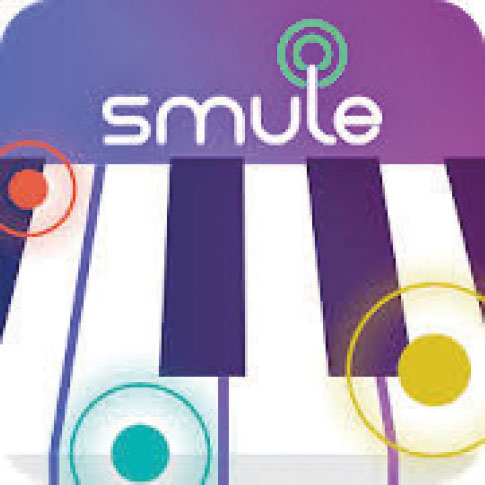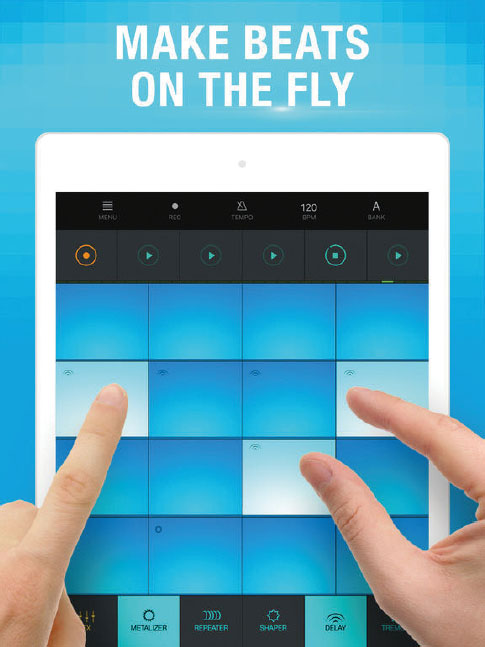
Magic Piano
FREE (in-app purchases)
The concept of Magic Piano will be familiar to anyone who has every played Guitar Hero or Rock Band on a games console. The idea is that dots float across the screen and you use your fingers to tap them as they pass a certain point, and if you tap them correctly – they play a tune.
The length of the gaps will change depending on the rhythm of the piece and the speed that you played the previous notes. Helpfully, the game actually pauses so you can keep up with it – the more accurate you are, and the faster you hit the dots, the closer to the original melody you get.

Magic Piano is part of the Smule family of apps
Magic Piano is available on both the iOS App Store and the Google Play store. I downloaded the app on to my iPhone and easily opened it up. Magic Piano has a paid version available that allows the user to access a wider range of songs. I had a look at the list and it's pretty extensive – the library of songs features classics alongside contemporary tracks that must be cool because I'm only vaguely familiar with them.
Although the musical content of such apps could be considered quite low, this is the first such game that allows the user to play wrong notes. If you tap slightly too far to the left or right – Magic Piano will play the notes you hit rather than the correct ones. It allows for mistakes in the same way pressing the wrongs notes on a real piano does.
Further, Magic Piano allows people to create their own pieces of music – and this is where it really has some value. In the compose window, the notes on the screen are labelled with the correct pitches, it shows the key and divides the floating time into beats and bars. You set up a new project and add a title and composer, it then gives you basic instructions on how to add notes. It's quite a quick process and the user can then save and upload it to the Smule library of songs for others to try and play. This could be a good app to encourage young composers to create a tune and they can get their friends (or their teacher) to have a go at playing their compositions.
Although basic, this app has some real potential as an additional learning resource, particularly to develop knowledge among younger students who are interested in composing.
Beat Maker Go
FREE (in-app purchases)

Beat Maker Go contains 16 pads each containing a sample
Beat Maker Go is currently the highest-ranked music creation app in the iOS mobile devices chart so I decided that it was worth investigating. I wanted to explore its capabilities and identify any uses that it might have in the classroom or practice room setting.
The app is a grid-based sequencer that features a range of samples and drum sounds loaded on to 16 pads, with a second set of 16 sounds hidden on a second bank of pads. The app is aimed squarely at modern genres of electronic dance music and more modern urban genres that also use electronic beats as their starting point.

Chart-topper: Beat Maker Go
Although I used an iOS device, the app is also available via the Google Play store. I was able to install it easily and quickly on to my device. When I opened it up, however, this is where my main complaint about the app appeared. Although the app advertises itself as free and features in-app purchases, the aggressiveness with which it markets these is terrible. It would be very easy for an unsuspecting student to sign up the account holder to a £7.99 weekly charge. I don't mind having adverts in an app – but the constant barrage of ‘sign up now’ notifications was unbearable.
Once I got past the ads and into the actual app, it was quite straightforward. You are greeted with a choice of different sample libraries to choose from. Once selected, the grid appears with sounds loaded into them. Above this is a record button, a metronome and some pre-recorded patterns. Recording your own beat is quite a quick process – simply hit the record button and choose one of the four pattern memories to record over. The app gives you two bars of 4/4 in which to create your ideas and it then starts looping, and you can continue to overdub additional elements until you stop the recording.
I like the fact that it allows the user to actually record a beat from the constituent elements of samples rather than assembling pre-programmed loops. There is actually some music skill involved here. It doesn't automatically quantise so the user needs to practise and create their beat in time to the metronome.
This app has some real potential for young musicians into EDM and similar genres if they are prepared to cope with the aggressive advertising or pay the subscription charge. As the name of the app indicates, this could be a quick tool for creating beats on the go.








